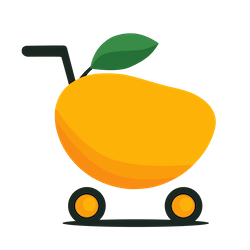Growth funnels, or pirate funnels, map how people discover, use, and share your business. They track Acquisition, Activation, Retention, Revenue, and Referral to find and fix weak points beyond just sales.
–
To audit your growth funnel in 10 minutes, jump to this section.
–
5 Stages of The Growth Funnel (AARRR)
The Short Version
When someone lands on your site or app for the first time, they’re at the Acquisition stage.
If they do something meaningful: sign up, add an item to their cart, try a feature – that’s Activation.
Sticking around after the first visit or action is Retention.
Buying, subscribing, upgrading, or paying is Revenue.
If they bring a friend or shout about you online, that’s Referral.
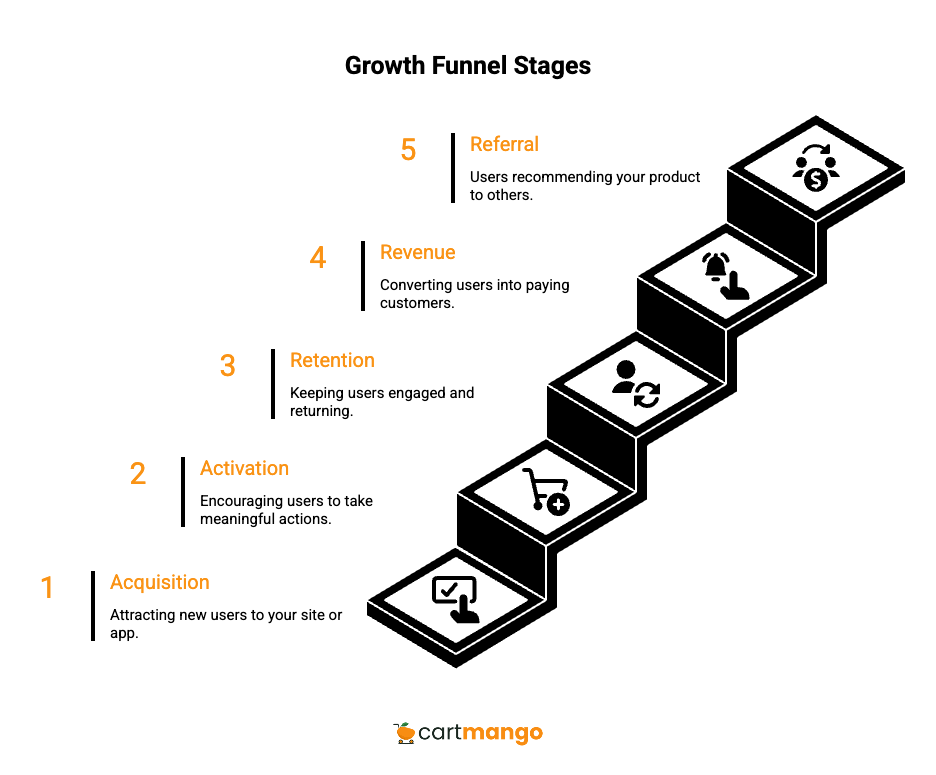
The Longer Version
When a person first discovers your product, they start in the Acquisition stage. This is the moment they see your ad, read your blog, or tap a link from a friend.
Acquisition is about getting your name in front of people who didn’t know you existed yesterday.
Maybe they click a Google ad, scroll past a Facebook post, or hear about you in a podcast. Realistically, only a portion of these people will visit your website or app, and that’s fine. The goal is to attract quality, not just quantity.
After they land on your page, the next step is Activation.
Activation means your visitor does something that signals real interest – like signing up for a free trial, downloading your app, filling out a contact form, or taking that critical “first action.”
Think of it as their first “aha moment.” If your onboarding process is confusing, or there are too many steps, activation rates drop quickly.
If a person returns after their first experience, you’ve reached Retention.
Retention is what separates one-time users from regulars. People come back when they find value. Maybe they receive a helpful email, a notification that matches their interest, or simply enjoy the user experience enough to make it a habit.
Revenue comes into play when someone becomes a paying customer.
Maybe this is a one-time purchase, a subscription, or an in-app upgrade. You want people to spend, but pressuring them too early often has the opposite result. Sometimes a smart upsell right after the activation moment works best.
Finally, Referral happens when happy users tell friends or share your business online.
This could mean sending a link, writing a review, or joining a referral program. Real-world programs, like Dropbox’s extra storage for invites, turn users into your best unpaid marketers.
Each stage matters, and when one lags, the whole funnel slows down. Tracking and improving every step is how growth funnels build momentum over time.
10-Min Growth Funnels Audit
Stage | What to Check | Your # (Last 30 Days) | “Why” Question to Ask | 1 Action to Try Next Week |
|---|---|---|---|---|
Acquisition | How many new visitors? Which channels work best? | Are you reaching your target audience? | Test a new channel or ad; tweak targeting | |
Activation | % who take first real action? (signup, add cart) | Is onboarding simple and welcoming? | Shorten steps, add a welcome/demo | |
Retention | % returning users after first action/visit | Do you follow up after first interaction? | Send follow-up email; push notification | |
Revenue | Paid conversions/avg. revenue per user | Is paying or upgrading easy and obvious? | Test a one-click offer or clearer pricing | |
Referral | %/number who refer or share | Do you ask for referrals or give rewards? | Launch or promote a referral program |
How to use it:
- Fill in your real numbers for “Your # (Last 30 Days)”.
- Reflect on the why behind each weak spot using the “Why” column.
- Pick 1 action for the next week from the final column. Focus there first to quickly fix bottlenecks.
You can re-run this audit every month to chart your growth funnel progress.
–
Here’s the AARRR Growth Funnels Audit table filled-in with an example for a coaching business:
Stage | What to Check | Your # (Last 30 Days) | “Why” Question to Ask | 1 Action to Try Next Week |
|---|---|---|---|---|
Acquisition | How many new visitors? Which channels work? | 820 (primarily from social media & Google) | Are you reaching your target audience? | Test LinkedIn posts targeting coaching niches |
Activation | % who sign up for free consult or resource | 98 (12% conversion from traffic) | Is onboarding simple and welcoming? | Simplify sign-up form; add an intro video |
Retention | % attending >1 live session or online event | 38 (39% of activators return) | Do you follow up after first session? | Send check-in emails after first session |
Revenue | Paid clients/session packages sold | 21 paid clients ($200 average per package) | Is it easy to buy or upgrade? | Add “Book Now” button; clarify package terms |
Referral | Clients who refer friends/share testimonials | 3 (14% of revenue-stage clients referred) | Do you ask for referrals or give rewards? | Launch referral program – discount for sharing |
Why Growth Funnels Beat Traditional Sales Funnels
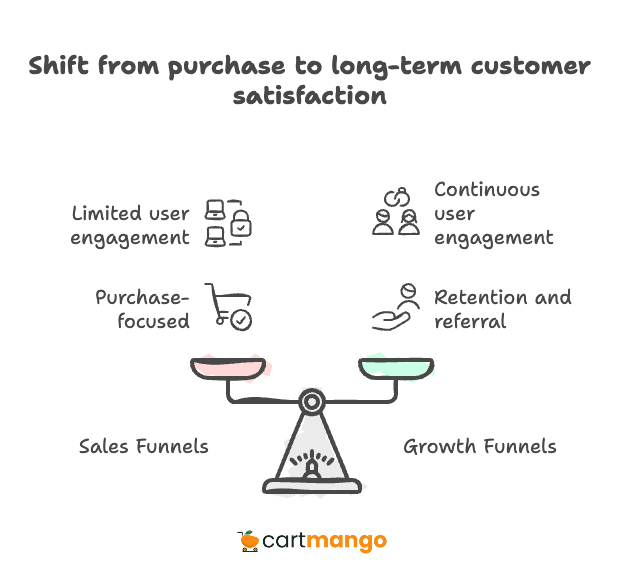
Most businesses track sales and call it a day.
That old system only tells you if someone buys. It misses what happens afterward. Growth funnels help you follow users long after the purchase, where real value builds up.
Sales funnels are linear. Someone lands, might buy, and then the story stops.
With growth funnels, you go beyond buying to retention and referral. Take Dropbox as an example. Their famous referral program gave users extra space for bringing friends. That moved their viral coefficient above 1 (source). This means each person using the product brings in more than one new person, creating a self-multiplying effect.
You’ll see more repeat buys, better reviews, and referrals.
If your business relies on repeat purchases, ongoing subscriptions, or user stickiness, growth funnels just work better.
Building Your Growth Funnel
Don’t try to fix everything at once. Start out with a map of your user’s journey.
- Where do they come from?
- What is their first action?
- What stops them?
You can sketch this out on paper or with tools like Google Analytics. Here’s a table to help structure your process.
Build Your Growth Funnel in 5 Steps
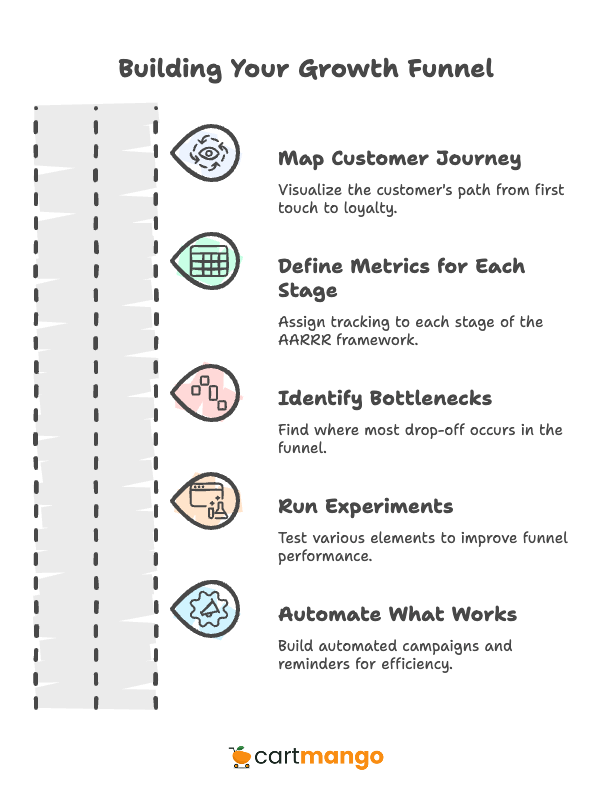
Step | Practical Actions | Recommended Tools/Resources | Data to Measure | Example Outcome |
|---|---|---|---|---|
Map Customer Journey | Visualize from first touch to loyalty | Google Analytics, mapping templates | Traffic sources, drop-offs | Journey diagram, pain points |
Define Metrics for Each Stage | Assign real tracking to AARRR stages | Funnel tracking sheets, analytics | Signup, activation rate, churn | Dashboard with benchmarks |
Identify Bottlenecks | Find where most drop-off occurs | Cohort analysis, user interviews | Stage conversion rates | List of bottlenecks |
Run Experiments | Test onboarding, landing pages, pricing | A/B testing tools (Optimizely, GA) | Changes in conversion/engagement | Improved funnel step |
Automate What Works | Build automated campaigns, reminders | Email marketing, CRM tools | Engagement, retention stats | Automated system, time saved |
Once your customer journey map is ready, define one or two metrics for each stage.
Maybe you only track cost per lead, activation rate, and retention after thirty days. That’s enough to get started.
Find which stage is losing most people. Onboarding, forgotten carts, churn after week one – these are typical pain points.
Then, devise simple experiments. Change the welcome flow. Try a new feature prompt, or edit your pricing page.
Every week, look at results. When something works, automate. Most email and CRM tools today let you set up triggered messages without much fuss.
Don’t overthink automation. If a welcome email brings users back for a second visit, automate that flow. Document what happens, especially when things don’t improve.
Optimizing Your Growth Funnel
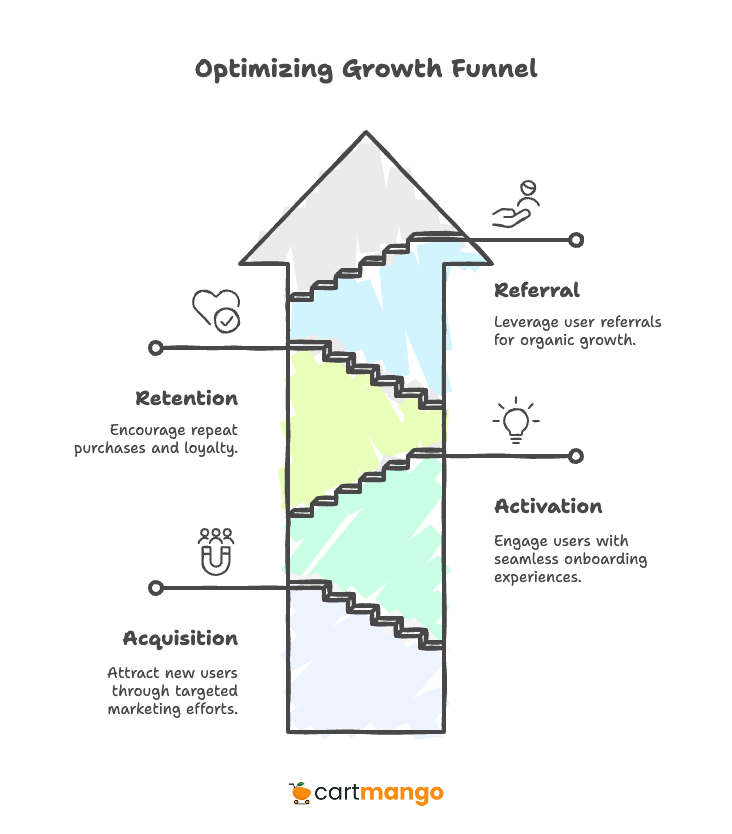
Acquisition
Start with acquisition. Are you targeting the right keywords? Paid ads work, but partnerships and content bring better users over time.
Retargeting picks up lost leads. About 26% of users return to a website as a direct result of retargeting campaigns (source).
Multi-channel marketing allows businesses to optimize marketing spend by up to 73.8% through better performance tracking across channels (source).
Don’t expect magic after one month. 3+ months is more realistic.
Activation
For activation, cut friction.
The shorter your signup or onboarding, the higher your activation rate. Progress bars and personalized product tours help.
Segment your messaging. If someone came from search, give them a quick win – maybe a custom tutorial or first-purchase discount.
Retention
Retention takes planning.
Win-back emails recover sleepers. Push notifications should relate to what a user cares about. Reward repeat purchases with loyalty points.
83% of consumers make repeat purchases because of loyalty programs, and 90% of loyalty program owners report positive ROI averaging 4.8 times their investment (source).
Boost revenue with bundles, upsells after activation moments, and payment flexibility. A/B testing pricing can lift conversions.
Referral
Want more organic growth? Referral links with pre-filled sharing messages generate more action.
Always reward both the sender and recipient.
When the timing is right, e.g. after solving a support issue or a positive product review, ask for referrals.
Common Growth Funnel Mistakes
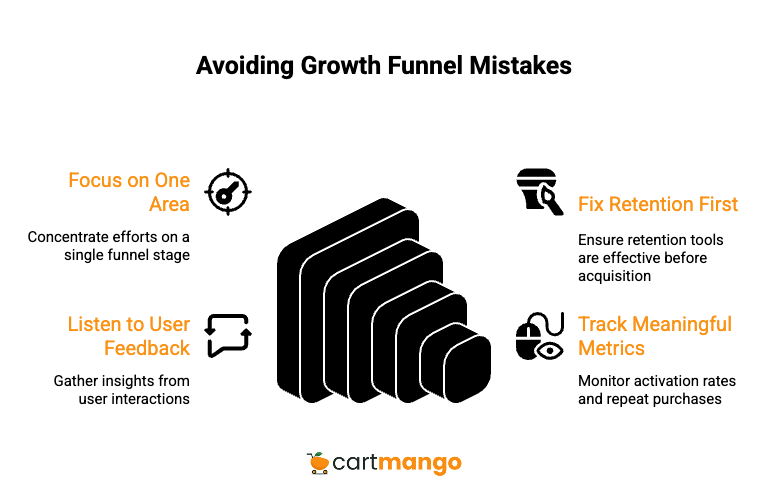
1/ Getting pulled in every direction is a recipe for confusion.
The smartest approach is to focus on just one area at a time. If most people drop off during activation, spend your effort there instead of spreading thin across all stages.
2/ Trying to fix ads while ignoring retention almost always wastes money.
If new users leave after their first click, pouring money into acquisition only builds a leaky bucket. Before launching new ad campaigns, check whether your retention tools are working.
3/ Chasing shiny ideas from competitors may look appealing.
But unless you check in with your users, you’re guessing. Analytics alone can highlight where the problem is, but not why people leave. Listen to feedback, support conversations, and surveys for the real story.
4/ Tracking vanity numbers like likes and clicks leads nowhere.
You’ll learn more from simple metrics: activation rates, repeat purchases, and actual referrals. This is a much clearer picture of growth than surface-level engagement.
Integrating Growth Funnels with Your Overall Marketing Strategy
Growth funnels are more than a tactical checklist. They provide a strategic framework for all your growth marketing efforts, from initial awareness to conversion and retention phases. Each growth funnel stage – acquisition, activation, retention, revenue, and referral – guides marketing teams across various digital channels.
Today’s growth marketing requires understanding your target audience and knowing that customer acquisition alone won’t guarantee sustainable growth. Businesses serious about achieving their growth targets invest in a growth marketing funnel that nurtures both new customers and existing users throughout the customer journey.
Performance marketing and demand generation tactics, such as search engines, ad campaigns, and social media marketing, expand organic traffic while capturing potential customers looking to solve a need.
Funnel strategies that include lead generation, content marketing, and email marketing help increase customer acquisition and move more users through the buying journey. Creative approaches – like unique social media posts, targeted mobile notifications, or a referral program – raise engagement without adding clutter.
Data-Driven Marketing That Powers Business Growth
Using a data-driven approach lets marketing efforts become more intelligent and efficient. Customer data provides deep insight into the effectiveness of different marketing strategies in each phase. Optimizing the growth funnel works best when businesses track conversion rates at every stage, from initial touch to revenue phases and beyond.
Digital teams who focus on the customer experience pay special attention to each of the key stages – from early acquisition to retention stages. By measuring customer engagement at every step, you find which revenue stages and retention strategies turn primary focus into increased revenue and recurring revenue streams.
Social media marketing isn’t just for blasting new promotions. It becomes a channel to build customer relationships, drive referral programs, and share all the necessary tools and tips with paying customers. High-impact content marketing keeps customers moving forward, supporting both existing users and bringing in more users from new sources.
Your Turn
Map your own growth funnel by tracking the journey step by step. Tackle one problem at a time. It usually pays off over months, not weeks.
Write down your steps, try new flows, document results, and keep learning. There will be bumps and pivots.
Consistency moves you forward, much more than chasing every “growth hack.” When in doubt, go with real data, not assumptions.
Related Reading
- Sellfy vs Payhip: The Recurring Revenue Prison (2026)
- Podia vs Gumroad: The Recurring Revenue Handcuffs (2026)
- SendOwl vs Gumroad: The Recurring Revenue Black Hole (2026)
- Gumroad vs Sellfy: The Vendor Lock-in Cage (2025)
- Gumroad vs Payhip: The Hidden Trap for Creators (2025)
- ThriveCart vs SamCart – The Subscription Hostage Trap (2025)
- 8 ThriveCart Alternatives & The Lifetime Pricing Paradox (2025)
- 8 SamCart alternatives + Subscription hostage (2025)
- The GENTLE Method: Soft marketing for creators
- How Far in Advance Should You Promote a Webinar?
